Abstract
1. A number of acetylenic-substituted steroidal and non-steroidal compounds, including 2,2-dipropargylacetamide, pregna-2,4-dien-20-yno[2,3-d]isoxazol-17-ol (Danazol) and acetylene gas, when administered to rats in vivo brought about a decrease in the concentrations of hepatic microsomal cytochrome P-450 and haem. Abnormal haem-breakdown products, `green pigments', and porphyrins accumulated in the livers of these animals. 2. For loss of microsomal cytochrome P-450 to occur in vitro, metabolic activation of the acetylenic substituent was necessary. The enzyme system responsible required NADPH and air, and was induced by pretreatment of rats with phenobarbitone; these are characteristics typical of the microsomal mixed-function oxidases. 3. When rats were dosed with 17α-ethynyl-17β-hydroxyandrost-4-en-3-one (ethynyltestosterone, 1mmol/kg) the pattern of green pigments extracted from the liver 4h after dosing and separated by t.l.c. was quite different from that in rats given 17β-hydroxy-17α-vinylandrost-4-en-3-one (vinyltestosterone), suggesting that reduction of the unsaturated triple bond to a double bond is not normally part of the metabolic activation pathway of the acetylenic substituent. 4. The green pigments extracted from the livers of rats 4h after the administration of the acetylenic-substituted compounds (1mmol/kg) when separated by silica-gel t.l.c. had variable RF values. The number and distribution of green pigments was characteristic for each compound examined. There was little correlation between the total loss of hepatic microsomal haem and the apparent intensity of the green pigments seen on the thin-layer chromatograms. 5. After incubation of [14C]acetylene in vitro with microsomal preparations from phenobarbitone-pretreated rats and a NADPH-generating system, no significant covalent binding to microsomal protein was detected over a 30min incubation period, although under similar conditions there was a significant loss of cytochrome P-450.
Full text
PDF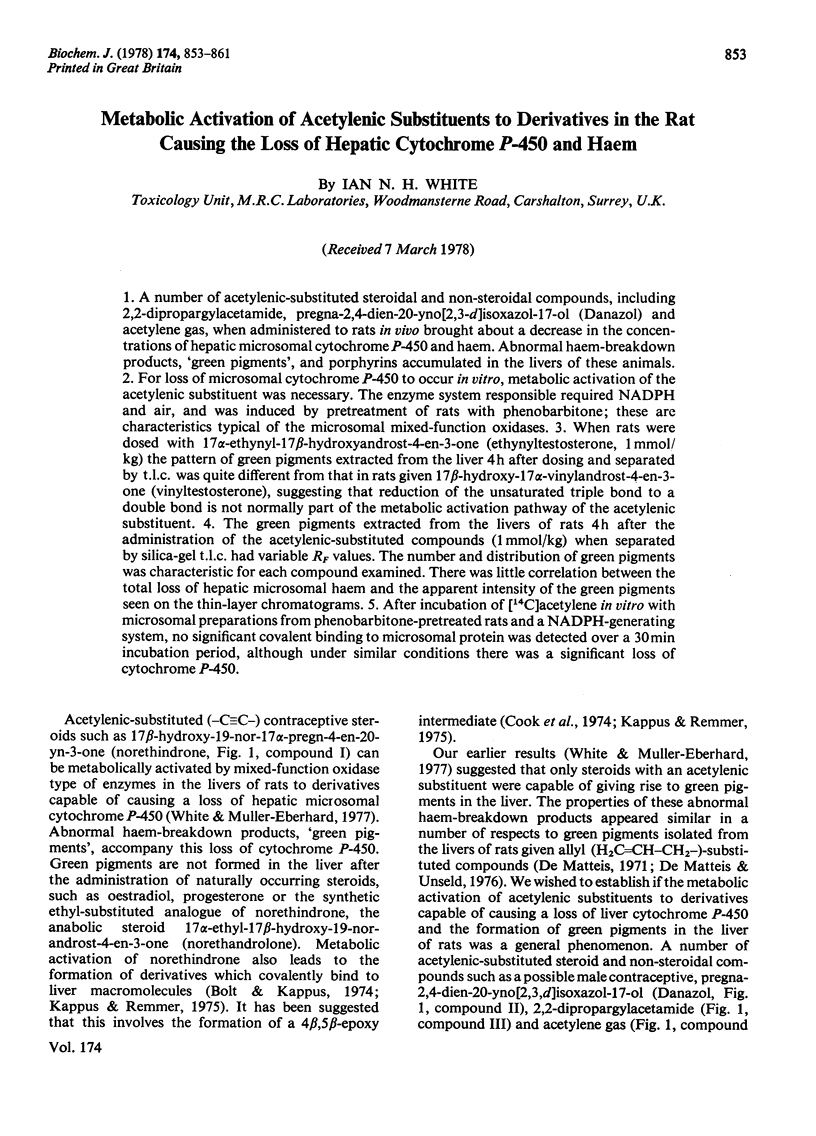


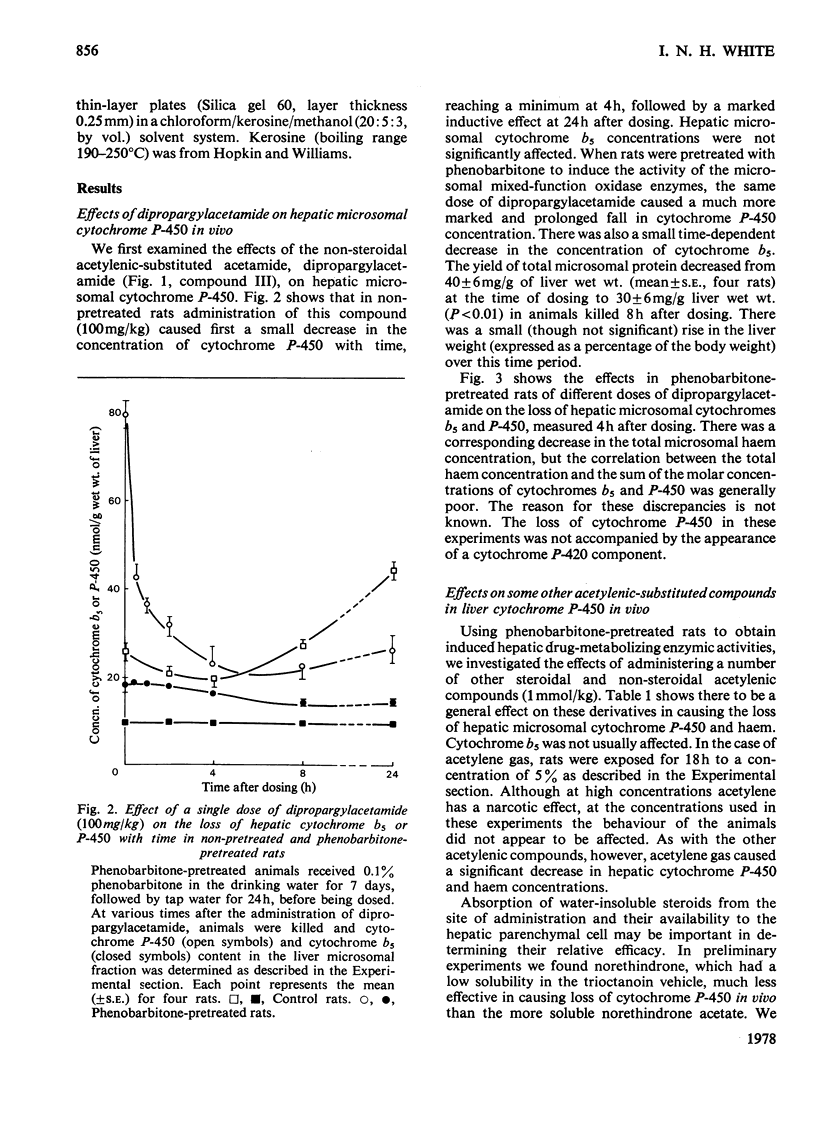

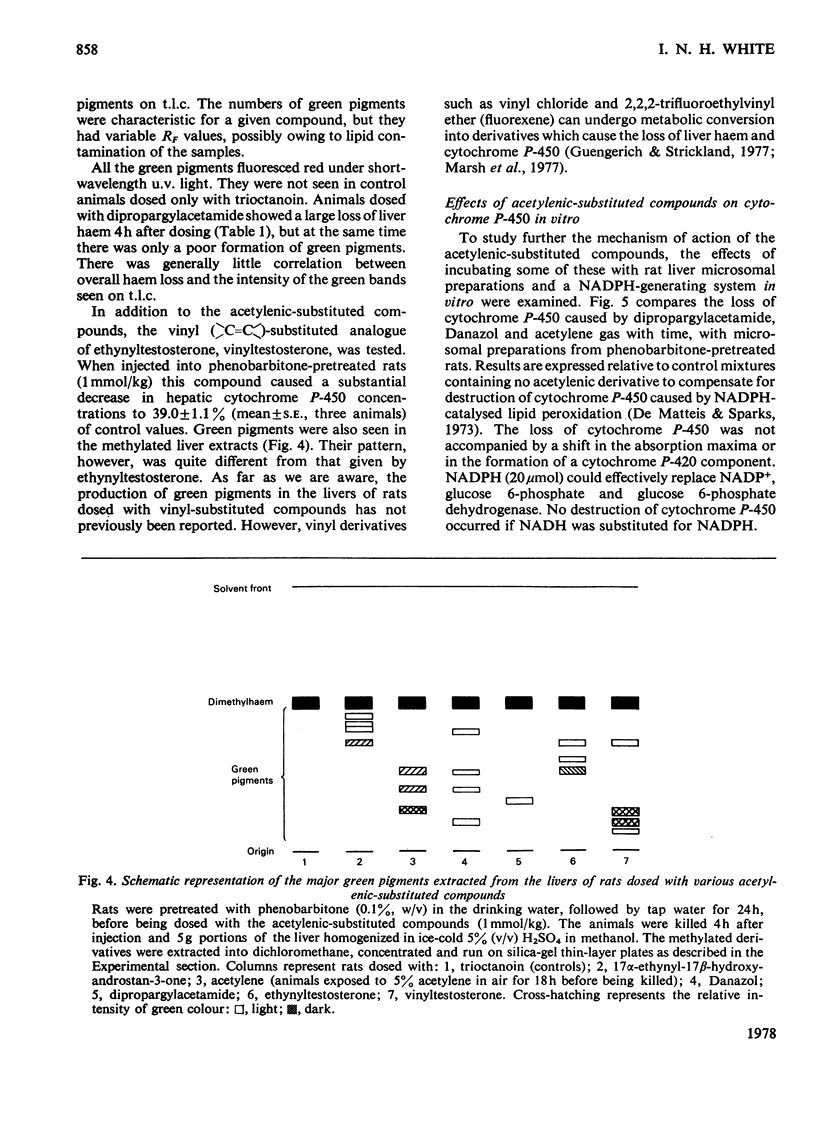
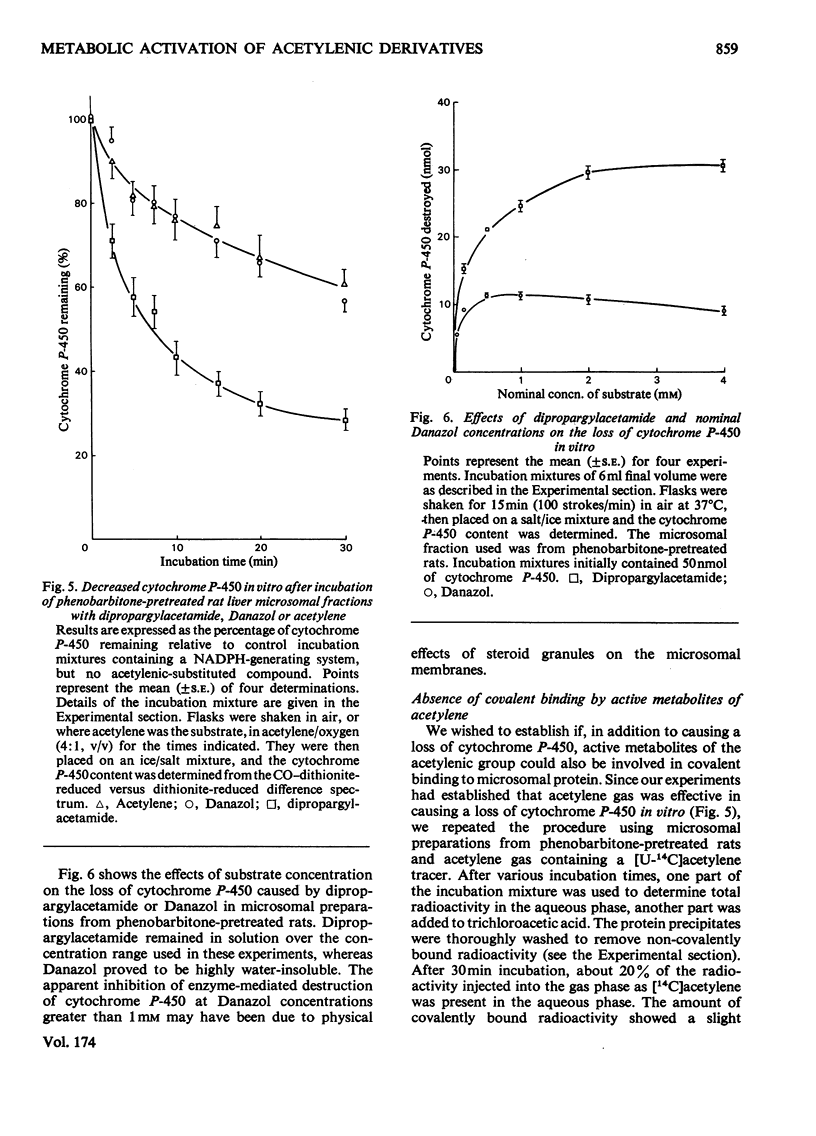
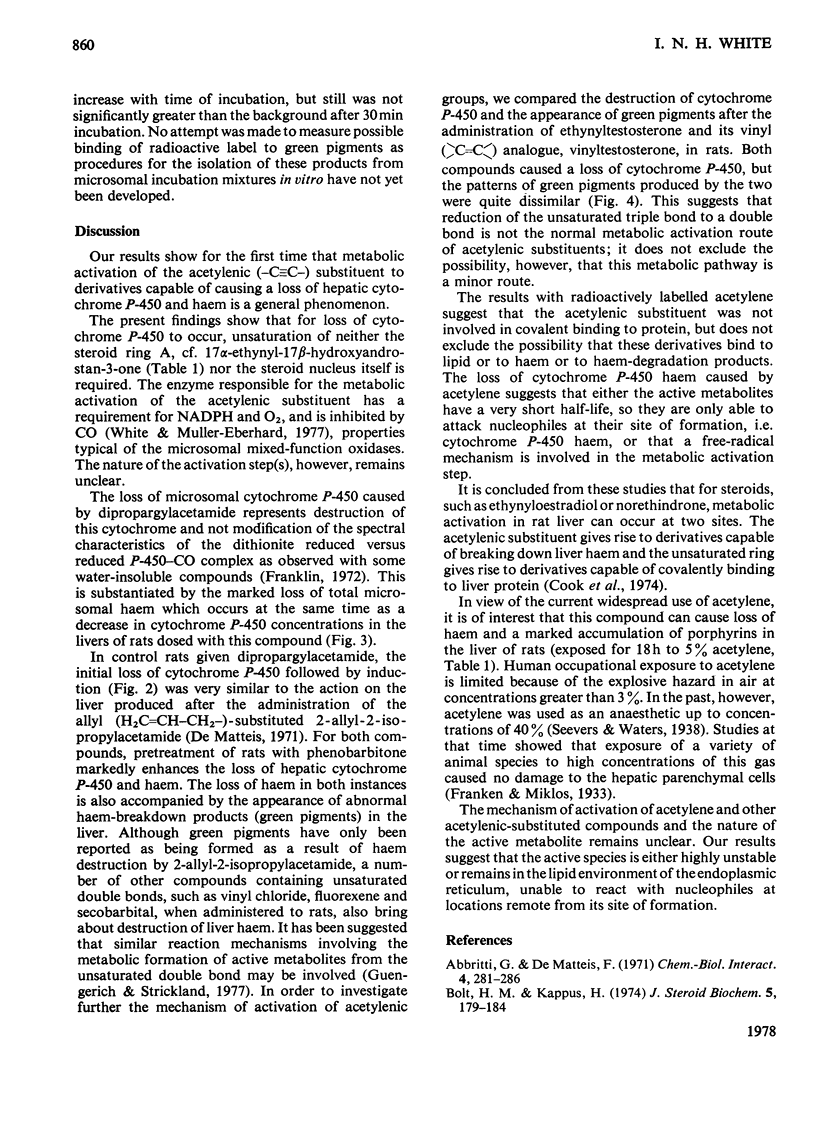
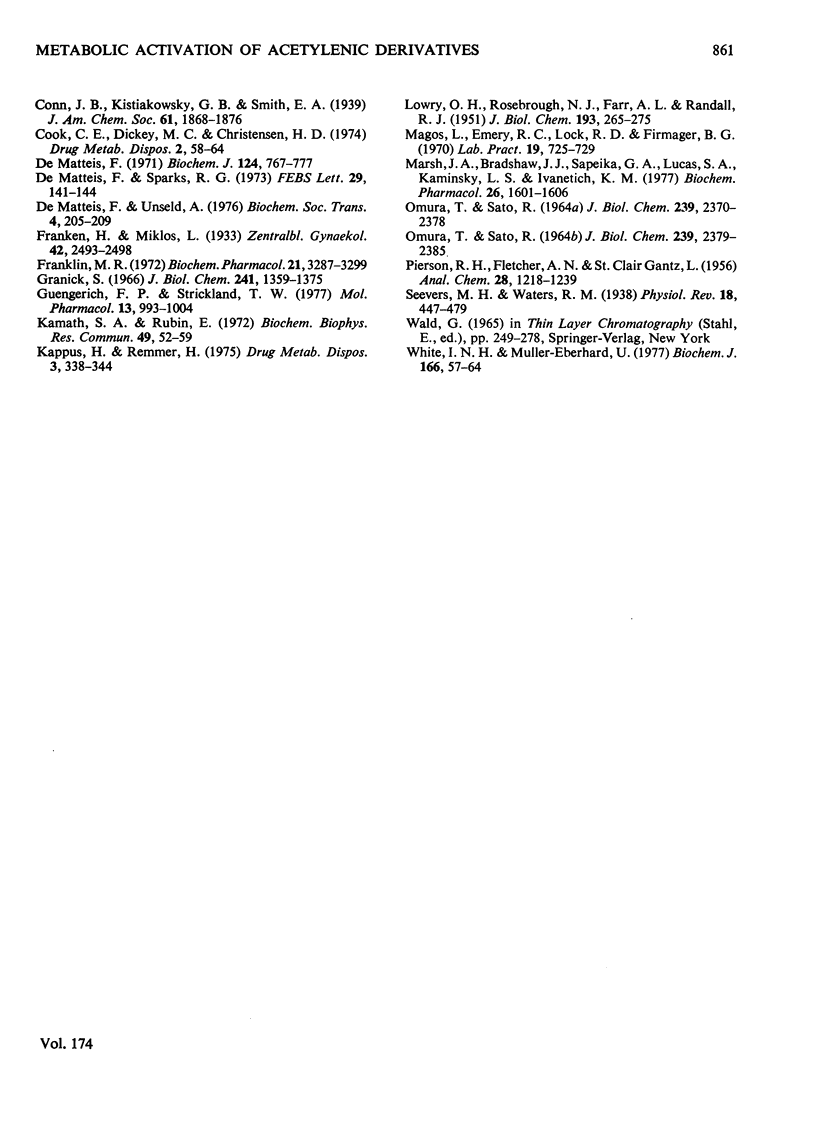
Selected References
These references are in PubMed. This may not be the complete list of references from this article.
- Abbritti G., De Matteis F. Decreased levels of cytochrome P-450 and catalase in hepatic porphyria caused by substituted acetamides and barbiturates. Importance of the allyl group in the molecule of the active drugs. Chem Biol Interact. 1972 Mar;4(4):281–286. doi: 10.1016/0009-2797(72)90022-1. [DOI] [PubMed] [Google Scholar]
- Bolt H. M., Kappus H. Irreversible binding of ethynyl-estradiol metabolites to protein and nucleic acids as catalyzed by rat liver microsomes and mushroom tyrosinase. J Steroid Biochem. 1974 Apr;5(2):179–184. doi: 10.1016/0022-4731(74)90126-5. [DOI] [PubMed] [Google Scholar]
- Cook C. E., Dickey M. C., Christensen H. D. Oxygenated norethindrone derivatives from incubation with beagle liver. Structure, synthesis, and biological activity. Drug Metab Dispos. 1974 Jan-Feb;2(1):58–64. [PubMed] [Google Scholar]
- De Matteis F. Loss of haem in rat liver caused by the porphyrogenic agent 2-allyl-2-isopropylacetamide. Biochem J. 1971 Oct;124(4):767–777. doi: 10.1042/bj1240767. [DOI] [PMC free article] [PubMed] [Google Scholar]
- De Matteis F., Sparks R. G. Iron-dependent loss of liver cytochrome P-450 haem in vivo and in vitro. FEBS Lett. 1973 Jan 15;29(2):141–144. doi: 10.1016/0014-5793(73)80545-9. [DOI] [PubMed] [Google Scholar]
- De Matteis F., Unseld A. Increased liver haem degradation caused by foreign chemicals: a comparison of the effects of 2-allyl-2-isopropylacetamide and cobaltous chloride. Biochem Soc Trans. 1976;4(2):205–209. doi: 10.1042/bst0040205. [DOI] [PubMed] [Google Scholar]
- Franklin M. R. Inhibition of hepatic oxidative xenobiotic metabolism by piperonyl butoxide. Biochem Pharmacol. 1972 Dec 15;21(24):3287–3299. doi: 10.1016/0006-2952(72)90093-7. [DOI] [PubMed] [Google Scholar]
- Granick S. The induction in vitro of the synthesis of delta-aminolevulinic acid synthetase in chemical porphyria: a response to certain drugs, sex hormones, and foreign chemicals. J Biol Chem. 1966 Mar 25;241(6):1359–1375. [PubMed] [Google Scholar]
- Guengerich F. P., Strickland T. W. Metabolism of vinyl chloride: destruction of the heme of highly purified liver Microsomal cytochrome P-450 by a metabolite. Mol Pharmacol. 1977 Nov;13(6):993–1004. [PubMed] [Google Scholar]
- Kamath S. A., Rubin E. Interaction of calcium with microsomes: a modified method for the rapid isolation of rat liver microsomes. Biochem Biophys Res Commun. 1972 Oct 6;49(1):52–59. doi: 10.1016/0006-291x(72)90008-3. [DOI] [PubMed] [Google Scholar]
- Kappus H., Remmer H. Metabolic activation of norethisterone (norethindrone) to an irreversibly protein-bound derivative by rat liver microsomes. Drug Metab Dispos. 1975 Sep-Oct;3(5):338–344. [PubMed] [Google Scholar]
- LOWRY O. H., ROSEBROUGH N. J., FARR A. L., RANDALL R. J. Protein measurement with the Folin phenol reagent. J Biol Chem. 1951 Nov;193(1):265–275. [PubMed] [Google Scholar]
- Magos L., Emery R. C., Lock R. D., Firmager B. G. A vertical-type constant flow inhalation chamber for rats. Lab Pract. 1970 Jul;19(7):725–727. [PubMed] [Google Scholar]
- Marsh J. A., Bradshaw J. J., Sapeika G. A., Lucas S. A., Kaminsky L. S., Ivanetich K. M. Further investigations of the metabolism of fluroxene and the degradation of cytochromes P-450 in vitro. Biochem Pharmacol. 1977 Sep 1;26(17):1601–1606. doi: 10.1016/0006-2952(77)90075-2. [DOI] [PMC free article] [PubMed] [Google Scholar]
- OMURA T., SATO R. THE CARBON MONOXIDE-BINDING PIGMENT OF LIVER MICROSOMES. I. EVIDENCE FOR ITS HEMOPROTEIN NATURE. J Biol Chem. 1964 Jul;239:2370–2378. [PubMed] [Google Scholar]
- OMURA T., SATO R. THE CARBON MONOXIDE-BINDING PIGMENT OF LIVER MICROSOMES. II. SOLUBILIZATION, PURIFICATION, AND PROPERTIES. J Biol Chem. 1964 Jul;239:2379–2385. [PubMed] [Google Scholar]
- White I. N., Muller-Eberhard U. Decreased liver cytochrome P-450 in rats caused by norethindrone or ethynyloestradiol. Biochem J. 1977 Jul 15;166(1):57–64. doi: 10.1042/bj1660057. [DOI] [PMC free article] [PubMed] [Google Scholar]


